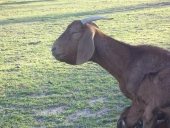posted 12 years ago
Hi,
Sorry, don't know how to post pictures, it we basically just have flat land with rich pasture grass, our soil is a rich sandy-loam. Don't know why, but no trees/shade in most paddocks though that is usual for New Zealand (in Australia most paddocks have a shade tree or two). The stocking rate is very high in this area, retired diary farmer next door and other neighbours do 1 or more cattle per acre and cut their own hay from that as well. In April, the vets did a farm visit as a freebee student training outing and said our stocking rate was far to low, and that the grass was growing too fast and not having much nutritional value, and they said to get mature cattle to get the grass down. We borrowed money to do this and get the fertiliser, and now have two adult cattle, 3 year-old calves, the 6 goats, two pigs and a few sheep. Even with that stocking, we are having trouble keeping the grass down, and the cows are just getting fatter and fatter. All our animals came from different life-style farmers, and clearly well-loved.
It is one goat in particular that got very skinny last April and is staying that way. The others are not fat, but not really skinny like her. We have two kids that are growing well. The two goats with kids were born only a year before and still not full-grown, so we thought it best not to milk them this year.
We have 10 paddocks in the rotation. We rotate the goats around a paddock in a movable electric netting fence, but don't make them graze it too low, and then we graze the sheep directly behind them. We then let the grass grow, and let the cattle graze it, if possible we do this twice. Then we let the grass grow and put the goats back into it.
We did a soil test for chemicals and nutritional elements when we bought the place 22 months ago, but did not realise it did not test for trace minerals. The vets found the selenium deficiency but normal copper through blood test. We since have put on a custom organic fertiliser that is meant to have all the trace elements included, and also have available a salt mineral lick.
The two pigs were got as diggers to break in the land for gardens, and also to dig the pasture and plant a more versified pasture behind them, and because my husband always wanted a pet pig. Keeping them contained where we want them to dig has also been a 8 month battle, but we have finally worked out a movable mesh tractor that we weigh down with logs attached to the sides.
We have water troughs/baths in every paddock that refill automatically on a float system. If they can't reach that in the goat rotation, then I put out a car tyre with a water bucket in it.
I do the best to vary their diet They used to have branches daily, though not so much now. When their paddocks start to get lower, I do often also cut them more stalky grass from places they have not grazed, or if I think it may be contaminated, then I dry it and give it to them. They absolutely love the long orchard grass / cocksfoot. With spring here now, and the pigs digging where they should, hopefully we can have a more varied diet in the next few months. We planted a small section of chicken food /orchard lay including white radishes/kale last year, and the kids kept breaking in to eat these. If I was to sell them then I know that they would simply go somewhere else with mainly just pasture grass, ans that is the norm in this area.








































































